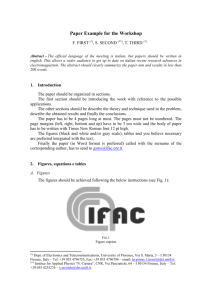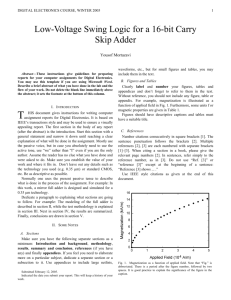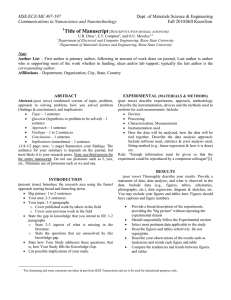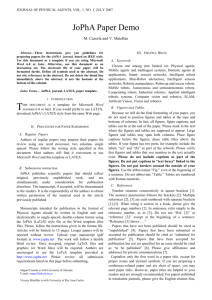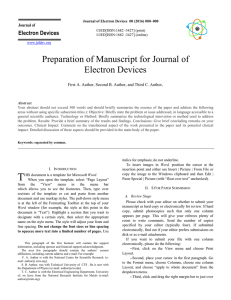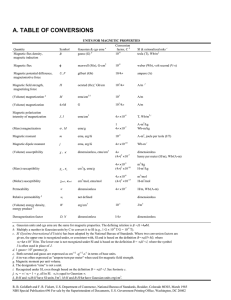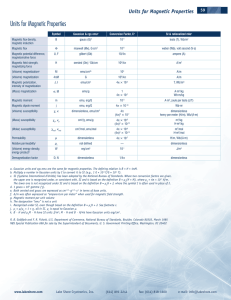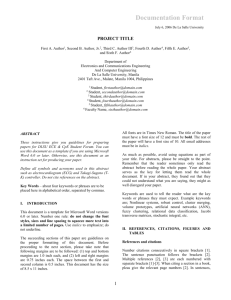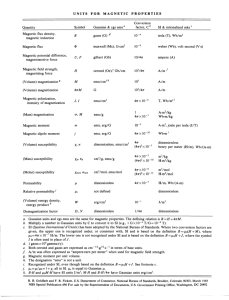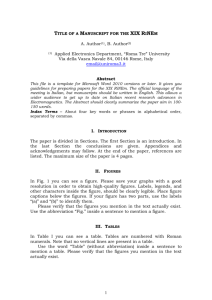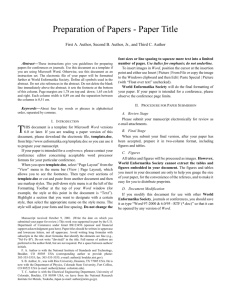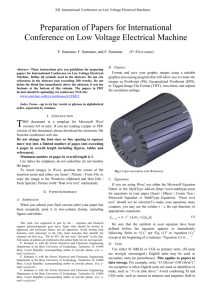Abstract Format
advertisement
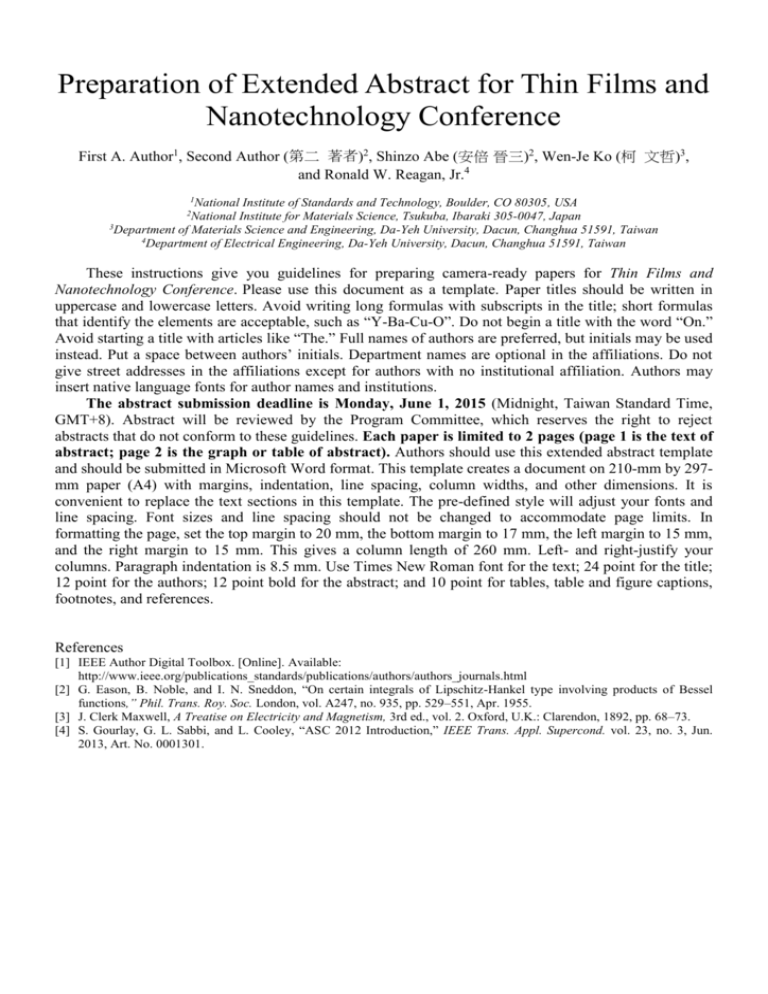
Preparation of Extended Abstract for Thin Films and Nanotechnology Conference First A. Author1, Second Author (第二 著者)2, Shinzo Abe (安倍 晉三)2, Wen-Je Ko (柯 文哲)3, and Ronald W. Reagan, Jr.4 1 National Institute of Standards and Technology, Boulder, CO 80305, USA National Institute for Materials Science, Tsukuba, Ibaraki 305-0047, Japan 3 Department of Materials Science and Engineering, Da-Yeh University, Dacun, Changhua 51591, Taiwan 4 Department of Electrical Engineering, Da-Yeh University, Dacun, Changhua 51591, Taiwan 2 These instructions give you guidelines for preparing camera-ready papers for Thin Films and Nanotechnology Conference. Please use this document as a template. Paper titles should be written in uppercase and lowercase letters. Avoid writing long formulas with subscripts in the title; short formulas that identify the elements are acceptable, such as “Y-Ba-Cu-O”. Do not begin a title with the word “On.” Avoid starting a title with articles like “The.” Full names of authors are preferred, but initials may be used instead. Put a space between authors’ initials. Department names are optional in the affiliations. Do not give street addresses in the affiliations except for authors with no institutional affiliation. Authors may insert native language fonts for author names and institutions. The abstract submission deadline is Monday, June 1, 2015 (Midnight, Taiwan Standard Time, GMT+8). Abstract will be reviewed by the Program Committee, which reserves the right to reject abstracts that do not conform to these guidelines. Each paper is limited to 2 pages (page 1 is the text of abstract; page 2 is the graph or table of abstract). Authors should use this extended abstract template and should be submitted in Microsoft Word format. This template creates a document on 210-mm by 297mm paper (A4) with margins, indentation, line spacing, column widths, and other dimensions. It is convenient to replace the text sections in this template. The pre-defined style will adjust your fonts and line spacing. Font sizes and line spacing should not be changed to accommodate page limits. In formatting the page, set the top margin to 20 mm, the bottom margin to 17 mm, the left margin to 15 mm, and the right margin to 15 mm. This gives a column length of 260 mm. Left- and right-justify your columns. Paragraph indentation is 8.5 mm. Use Times New Roman font for the text; 24 point for the title; 12 point for the authors; 12 point bold for the abstract; and 10 point for tables, table and figure captions, footnotes, and references. References [1] IEEE Author Digital Toolbox. [Online]. Available: http://www.ieee.org/publications_standards/publications/authors/authors_journals.html [2] G. Eason, B. Noble, and I. N. Sneddon, “On certain integrals of Lipschitz-Hankel type involving products of Bessel functions,” Phil. Trans. Roy. Soc. London, vol. A247, no. 935, pp. 529–551, Apr. 1955. [3] J. Clerk Maxwell, A Treatise on Electricity and Magnetism, 3rd ed., vol. 2. Oxford, U.K.: Clarendon, 1892, pp. 68–73. [4] S. Gourlay, G. L. Sabbi, and L. Cooley, “ASC 2012 Introduction,” IEEE Trans. Appl. Supercond. vol. 23, no. 3, Jun. 2013, Art. No. 0001301. Thin Films and Nanotechnology Conference 2015 TABLE I UNITS FOR MAGNETIC PROPERTIES (SHORT TITLE HERE IN SMALL CAPS) Symbol B Fig. 1. Magnetization as a function of applied field. Note that “Fig.” is abbreviated. There is a period after the figure number, followed by two spaces. It is good practice to explain the significance of the figure in the caption. Quantity H m magnetic flux magnetic field, magnetic flux density magnetic field strength magnetic moment M magnetization 4M j J magnetization specific magnetization magnetic dipole moment magnetic polarization , susceptibility mass susceptibility permeability r w, W N, D relative permeability energy density demagnetizing factor Conversion from Gaussian and CGS EMU to SI a 1 Mx 108 Wb = 108 V·s 1 G 104 T = 104 Wb/m2 1 Oe 103/(4) A/m 1 erg/G = 1 emu 103 A·m2 = 103 J/T 1 erg/(G·cm3) = 1 emu/cm3 103 A/m 1 G 103/(4) A/m 1 erg/(G·g) = 1 emu/g 1 A·m2/kg 1 erg/G = 1 emu 4 1010 Wb·m 1 erg/(G·cm3) = 1 emu/cm3 4 104 T 1 4 1 cm3/g 4 103 m3/kg 1 4 107 H/m = 4 107 Wb/(A·m) r 1 erg/cm3 101 J/m3 1 1/(4) No vertical lines in table. Statements that serve as captions for the entire table do not need footnote letters. A longer description of the table would go here. a Gaussian units are the same as cgs emu for magnetostatics; Mx = maxwell, G = gauss, Oe = oersted; Wb = weber, V = volt, s = second, T = tesla, m = meter, A = ampere, J = joule, kg = kilogram, H = henry.
